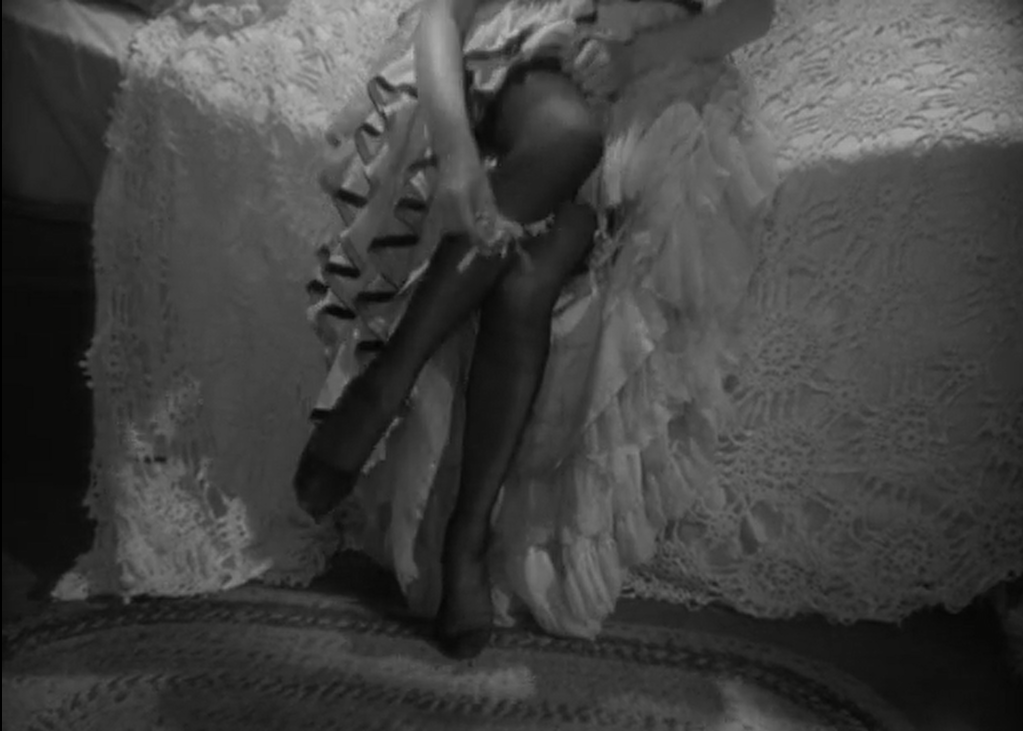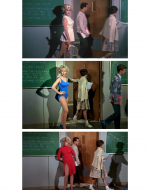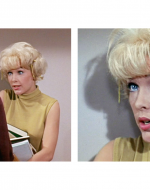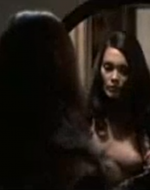Created by Allison Wooton on Tue, 11/22/2022 - 22:52
Description:
Introduction
The story of Dr.Jekyll and Mr.Hyde is resoundingly popular and has taken shape in many forms. Although each form of the story comes from a different angle or enhances different themes, there’s one thing that hasn’t changed since the original: the lowly depiction of women.
Beginning with the widely known novel Strange Case of Dr.Jekyll and Mr.Hyde, author Robert Louis Stevenson hardly includes depictions of women, showcasing how meek women were seen as in 1886. The only non-man characters were that of a prostitute and a maid; neither of those characters were looked at with splendure at the time. The first play adaptation of the book, Hyde, written by Thomas Russell Sullivan in collaboration with Richard Mansfield, is the first adaptation to include a love interest for the dynamic duo, however she isn’t showcased as much more than a woman head over heels for a man with a secret.
As time went on and more depictions of Jekyll and Hyde were made toward the middle of the 20th century, women did become more popular for the story in the movie industry… but not in the best of ways. Movie adaptations of the original novel seem to depict women as sex objects for men in power. This dynamic is no surprise considering Hollywood is run by, and for, men, especially at the point in time these adaptations were made. Laura Mulvey describes this objectification as scopophilia: a love of looking at “...people as objects, subjecting them to a controlling and curious gaze” (Mulvey, 59). This is extremely evident in many adaptations, but the gallery highlights Rouban Mamoullian’s 1931 movie Dr.Jekyll and Mr.Hyde, Jerry Lewis’ 1963 The Nutty Professor, and Roy Ward Bakers 1972 Dr.Jekyll and Sister Hyde.
All three of these adaptations depict women in sexual ways through the male gaze of Dr.Jekyll, or his adaptation counterpart. This specific gallery will focus on point-of-view shots structured as the male character looking, or watching, the female character. There is also an emphasis on the power dynamics of this structure and what it may be doing to satisfy scopophilia.
Sources
Baker, Roy. (1971). Dr. Jekyll & sister hyde.
Dr.Jekyll and Mr.Hyde.
Escott, J., & Stevenson, R. L. (2019). Dr Jekyll and mr hyde. Pearson Education Limited.
Laura Mulvey: Visual pleasure and narrative cinema. (2002). The Routledge Reader in Gender and Performance, 296–301. https://doi.org/10.4324/9780203143926-60
Lewis, J., & Lewis, J. (1963). The nutty professor. United States; Paramount.
Mamoulian, Rouben. (1931). Dr. Jekyll and Mr. Hyde. Paramount Pictures.
Image 1 - Ivy Undressing
Mamoulian, Rouben. (1931). Dr. Jekyll and Mr. Hyde. Paramount Pictures. - 00:20:44
In this image from Rouben Mamoulian’s Dr.Jekyll and Mr.Hyde, we see a woman, Ivy, taking off her stockings while sitting on a bed. By just looking at the image, one may be able to tell there’s a sexual something at play here.
This particular still is from the point of view of Dr.Jekyll. Just before this still, he walks away from Ivy on the bed and the camera angle changes. We begin looking at her face and then the camera pans down to just her legs. The use of camera work here allows us to understand that we are currently watching Ivy from Dr.Jekyll’s perspective. This is an example of Mulvey’s idea of camera work helping to maintain the male gaze (Mulvey, 68).
The excitement in her pointed toes and the fact she’s sitting on a bed helps us to pick up on the sexual tension that Jekyll is feeling from watching her. This also comes across in the fact that the camera lingers for so long on her taking off her stockings, almost as if portraying the fact that Jekyll can’t, or doesn’t want to, look away.
It’s also important to note the definite power dynamic between Ivy and Jekyll and how it intensifies the objectification of women in this case. Ivy is a lowly prostitute who just had her life saved by Jekyll, whereas Jekyll is a high class doctor who would never lust over someone in the position of Ivy, not to mention the fact he’s to be married. Through this scene, Jekyll is making out as though Ivy is in the wrong for flirting and leading him on, instead of himself being in the wrong for looking, wanting to look, and wanting to cheat. This intensifies the objectification because not only are women’s bodies being objectified as a sex object in this scene, they’re also being objectified in terms of being men’s reasons to lose their morality.
Image 2 - Kelp Fantasizing about Stella
Lewis, J., & Lewis, J. (1963). The nutty professor. United States; Paramount. - 00:52:50
In this image, we see multiple fantasies of Stella, the main love interest in the Jekyll and Hyde adaptation The Nutty Professor. As Professor Kelp (the adapted version of Dr.Jekyll) continually fantasizes about Stella, her outfits get more and more suggestive, although they never left too much to the imagination to begin with.
The beginning of this scene shows Kelp as he watches Stella walk towards the door of the classroom, when the camera cuts back to Stella each time she’s in a new outfit and posing in a new way. The camera work here helps to suggest that Kelp is watching his own fantasy which is many different fantasies of Stella. Like noted before, as the scenes progress, Stella’s outfits in Kelp’s mind become more and more suggestive. She seems like a woman straight out of a PlayBoy Magazine; “...the woman as icon, displayed for the gaze and enjoyment of men” (Mulvey, 64).
Furthermore, it’s important to point out the power dynamic between Kelp and Stella, too: teacher and student. This makes this analysis even more interesting. Thinking of the power that Kelp automatically has over Stella as the person with more power in their social setting, you can create a parallel to the fact that he has the power over what she’s wearing, how she’s standing and what she’s doing in his fantasy. This is a really great example of Mulvey’s point about women displayed in cinema for men’s enjoyment (Mulvey, 64).
Image 3 - Stella Invites Kelp to the Purple Pit
Lewis, J., & Lewis, J. (1963). The nutty professor. United States; Paramount. - 00:26:54
In this image, Stella is inviting Professor Kelp to a get together at a local club called the Purple Pit. In this adaptation, The Nutty Professor, this scene can be paralleled to Mamoullian’s first scene with Ivy. In both of these scenes, the women are playing a character that is in a less powerful position than Dr.Jekyll/Professor Kelp and it’s also the first time the character is feeling a sort of temptation to do something they know is wrong. For Kelp, he’s telling Stella he can’t attend the Purple Pit because he’s a staff member of the school (although he really would like to) and Dr.Jekyll tells Ivy she should go to sleep and almost shrugs her off as she’s trying to seduce him (although he isn’t really shrugging her off, moreso stringing her along).
In terms of just the adaptation, though, this scene once again brings to the forefront the power dynamic of Stella and Kelp. Although we already know he’s a professor and she’s a student, the camera angle helps to emphasize the difference in their power: in the still where both characters are pictured, we can clearly see that despite Kelp being a relatively small man compared to other men in the movie, he’s still taller than Stella. She’s slightly looking up to him while he’s looking down on her.
This still is also different because the objectification may not be quite as obvious. The objectification in this scene comes more from the way in which Stella is depicted and how she’s playing a character for the male gaze. As Stella talks, her voice is extremely rhythmic and soft. Not to mention her makeup is done to make her look young and almost child-like. Towards the end of this scene, a filter is placed on the screen and Stella looks almost angelic. She’s also saying all the things a man may want her to say. She ends the scene by looking up into the camera and essentially breaking the fourth wall and she smiles and winks. This heavy emphasis on Stella and the breaking of the fourth wall is to help include the audience in the scopophilia while also allowing the male audience to identify as Kelp: aka a man who is being told exactly what he wants to hear. This idea of identification also comes from Laura Mulvey and is simply the idea that identification in film through seeing something you want to see, do, be, hear, etc. builds the ego in the audience (Mulvey, 59).
Image 4 - Sister Hyde After the Initial Transformation
Baker, Roy. (1971). Dr. Jekyll & sister hyde. - 00:02:50
Dr.Jekyll and Sister Hyder is a more out of the box adaptation of Jekyll and Hyde where Hyde is Jekyll’s even counterpart as a woman. This in and of itself is a lot to unpack, but we’re most interested in what it means for the objectification of women. In this scene, Dr.Jekyll has taken the first dose of his serum and has undergone his initial transformation. Once the transformation was complete, Sister Hyde began to look at himself in the mirror which led to him ripping the coat he’s wearing open and staring at the womanly breasts on his chest.
Notice, although Sister Hyde’s name begins with “sister” and he looks like a woman, it’s important to remember that Sister Hyde is an entity of Dr.Jekyll; in fact, Sister Hyde is the evil version of Dr.Jekyll, so they are the same person. This also plays into the power dynamic roles that the two play. Although Hyde might be in a powerful position throughout most adaptations considering he takes over the body of Jekyll, in this instance the body of Sister Hyde is less powerful than the mind and eyes and Dr.Jekyll. It’s clear that in this image, Sister Hyde is staring very intently at her breasts; so Dr.Jekyll is staring intently at a woman’s body that is not his. The body of Sister Hyde still has less power than Dr.Jekyll does in this instance.
The power dynamic really spoke for itself in terms of objectification of women, too. The evilness in Jekyll’s mind is the reason Sister Hyde does everything she does. The male gaze wanted her to be topless and to show off her body and that’s portrayed through this concept. This scene is also a direct parallel to an idea Mulvey talks about in her article. She explains that “...the original moment of recognition in front of the mirror…” leads to a powerful ego (Mulvey, 63). Because Jekyll can recognize this evil version of himself in front of the mirror and make it do what it wants (no matter what it looks like). The objectification of women’s body in this adaptation directly feeds the male gaze and ego.





